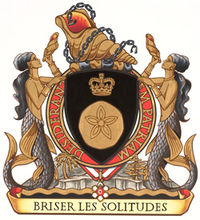Michaëlle Jean
| Her Excellency The Right Honourable Michaëlle Jean CC, CMM, COM, CD, FRCPSC(hon) |
|
 |
|
|
|
|
|---|---|
| Incumbent | |
| Assumed office September 27, 2005 |
|
| Monarch | Elizabeth II |
| Prime Minister | Paul Martin Stephen Harper |
| Preceded by | Adrienne Clarkson |
| Succeeded by | David Lloyd Johnston (Designate) |
|
|
|
| Born | September 6, 1957 Port-au-Prince, Haiti |
| Spouse(s) | Jean-Daniel Lafond |
| Alma mater | University of Montreal University of Florence University of Perugia Catholic University of the Sacred Heart |
| Profession | Journalist |
| Signature | |
Michaëlle Jean CC CMM COM CD FRCPSC(hon) (French pronunciation: [mika.ɛl ʒɑ̃]; born September 6, 1957) is a Canadian journalist and stateswoman. She is the current Governor General of Canada, the 27th since Canadian Confederation.
Jean was a refugee[1] from Haiti — coming to Canada in 1968 — and was raised in the town of Thetford Mines, Quebec. After receiving a number of university degrees, Jean worked as a journalist and broadcaster for Radio-Canada and the Canadian Broadcasting Corporation (CBC), as well as undertaking charity work, mostly in the field of assisting victims of domestic violence. In 2005, she was appointed as governor general by Elizabeth II, Queen of Canada, on the recommendation of Prime Minister Paul Martin, to replace Adrienne Clarkson as vicereine. At the time, comments of hers recorded in some of the film works by her husband, Jean-Daniel Lafond, were construed as supporting Quebec sovereignty and her holding of dual citizenship caused doubt about her loyalties. But Jean denied separatist leanings, renounced her citizenship of France, and eventually became a respected vicereine.
As governor general, Jean is entitled to be styled Her Excellency while in office, and The Right Honourable for the duration of her viceregal tenure and life beyond; given current practice, she will be sworn in to the Queen's Privy Council for Canada when her term as the Queen's representative ends, scheduled for October 1, 2010. It is planned that, after departing the viceregal post, Jean will serve as Special Envoy to Haiti for the United Nations Educational, Scientific and Cultural Organization.
Contents |
Early life and youth
Jean's family hails from Haiti; she was born in Port-au-Prince, baptised at the Holy Trinity Cathedral,[2][3] and spent winters in that city and summers and weekends in Jacmel, her mother's hometown.[4] With her family, Jean fled Haiti in 1968 to escape the regime of dictator François Duvalier — who had tortured Jean's philosopher father and separated him from his family for more than 30 years — and, upon arrival in Canada, the family settled first in a basement apartment in Montreal and then at Thetford Mines, Quebec.[3][5]
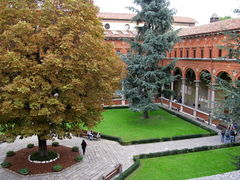
Jean received a Bachelor of Arts degree in Italian and Hispanic languages and literature from the University of Montreal, and, from 1984 to 1986, taught Italian studies while completing her Master of Arts degree in comparative literature. She then went on with language and literature studies at the University of Florence, the University of Perugia, and the Catholic University of Milan. Besides French and English, Jean is fluent in Spanish, Italian, and Haitian Creole, and can read Portuguese.[5]
Concurrent with her studies between 1979 and 1987, Jean worked at a women's shelter, which paved the way for her establishment of a network of shelters for women and children across Canada. She also involved herself in organisations dedicated to assisting immigrants to Canada obtain the entry they desired, and later worked for Employment and Immigration Canada and at the Conseil des Communautés culturelles du Québec, where Jean began writing about the experiences of immigrant women.[5] She married French-born, Canadian filmmaker Jean-Daniel Lafond, and the couple adopted as their daughter Marie-Éden, an orphaned child from Jacmel.[6]
Journalism
Jean became a reporter, filmmaker, and broadcaster for Radio-Canada in 1988,[2][5] hosting news and affairs programmes such as Actuel, Montréal ce soir, Virages, and Le Point. She then moved in 1995 to Réseau de l'information (RDI), Radio-Canada's all-news channel, in order to anchor a number of programmes, Le Monde ce soir, l'Édition québécoise, Horizons francophones, Les Grands reportages, Le Journal RDI, and RDI à l'écoute, for example. Only four years later, however, she was asked by CBC's English language all-news channel, CBC Newsworld, to host The Passionate Eye and Rough Cuts, which both broadcast the best in Canadian and foreign documentary films. By 2004, Jean was hosting her own show, Michaëlle, while continuing to anchor RDI's Grands reportages, as well as acting occasionally as anchor of Le Téléjournal.[5]
Over the same period, Jean made several films with her husband, including the award winning Haïti dans tous nos rêves ("Haiti in All Our Dreams"),[2] in which she meets her uncle, the poet and essayist René Depestre, who fled from the Duvalier dictatorship into exile in France and wrote about his dreams for Haiti, and tells him Haiti awaits his return. She similarly produced and hosted news and documentary programming for television on both the English and French services of the CBC.[5]
Governor generalship
Jean is Canada's first governor general of Caribbean origin; the third woman (after Jeanne Sauvé and Adrienne Clarkson); the fourth youngest (after the Marquess of Lorne, who was 33 years old in 1878; the Marquess of Lansdowne, who was 38 years old in 1883; and Edward Schreyer, who was 43 years old in 1979); the fourth former journalist (after Sauvé, Roméo LeBlanc and Clarkson); and the second after Clarkson to not only have neither a political nor military background, but also to be a visible minority, to break the tradition of Canadian-born governors general, and to be in an interracial marriage. Jean is also the first representative of Queen Elizabeth II to have been born during the latter's reign, and her appointment saw the first child living in Rideau Hall since Schreyer and his young family lived there in the early 1980s.
As governor general-designate
It was on August 4, 2005 announced from the Office of the Prime Minister of Canada that Queen Elizabeth II had, by commission under the royal sign-manual and Great Seal of Canada, approved Prime Minister Paul Martin's choice of Jean to succeed Adrienne Clarkson as the Queen's representative. At the time, Martin said of Jean that she "is a woman of talent and achievement. Her personal story is nothing short of extraordinary. And extraordinary is precisely what we seek in a governor generalship — who after all must represent all of Canada to all Canadians and to the rest of the world as well."[7] Almost immediately, there was speculation that Martin had been influenced by the political climate in Ottawa at the time, leading the Prime Minister to deny that rejuvenated popularity for his party in Quebec was a motivating factor in his decision.

From Her Majesty's Loyal Opposition, the upcoming appointment was met with mostly favourable comments,[n 1] and Jean's predecessor applauded the choice, saying that Jean was "an exciting and imaginative choice for Governor General."[10] In her first remarks after this announcement, Jean herself encouraged Canadians to involve themselves in their communities, and stated that she wished to reach out to all Canadians, regardless of their background, and made it a goal to focus especially on Canadian youth and the disadvantaged.
However, by August 11, 2005, reports emerged of a forthcoming piece by René Boulanger for the Quebec sovereigntist publication Le Québécois that would reveal Jean and her husband's support for Quebec independence, citing Lafond's associations with former members of the terrorist organisation, the Front de libération du Québec (FLQ),[11] specifically Jacques Rose. Though Boulanger admitted that he was motivated to incite a rejection of Jean by Anglophone Canadians, Gilles Rhéaume, former president of the Saint-Jean-Baptiste Society, called on the Governor General-Designate to reveal how she voted in Quebec's 1995 referendum on independence,[12][13] and Members of Parliament, as well as some provincial premiers, demanded that Jean and her husband clarify where their sympathies lay.[14] Then, four days after the Prime Minister publicly explained that Jean and her spouse had both undergone thorough background checks by the Royal Canadian Mounted Police and the Canadian Security Intelligence Service,[14][15] on August 17, there came to light the existence of a documentary in which Jean had been filmed with several hard-line Quebec separatists, all toasting "to independence" after Jean stated: "Independence can't be given, it must be taken."
It was on that day that Jean responded with a public statement, saying "I wish to tell you unequivocally that both my husband and I are proud to be Canadian and that we have the greatest respect for the institutions of our country. We are fully committed to Canada. I would not have accepted this position otherwise... [We] have never belonged to a political party or the separatist movement," and went on to say that in the documented footage she had been speaking about Haiti, and not Quebec. Martin added on his earlier comments: "There is no doubt in my mind that her devotion to Canada is longstanding and resolute,"[16] though some critics continued to argue that Jean's response had been too vague. By late August, polls showed that there had been a 20% drop in support for the recommendation of Jean as the next governor general, in response to which the Haitian community voiced their support for Jean, even holding special church services in her honour.[17]
The Queen held audience with Jean and her family on September 6, 2005 at Balmoral Castle. Though this type of meeting with a governor general-designate was standard, Jean's was unique in that the presence of her young daughter marked the first time in Elizabeth's reign that her designated viceroy-to-be had brought a child to an audience. Though the meeting went well, upon her return to Canada, Jean yet again became a target when the subject of her dual citizenship was raised, in particular the French variety she had obtained through her marriage to the French-born Lafond. A section of the French civil code forbade French citizens from holding government or military positions in other countries, yet Jean, as governor general, would hold a governmental position as the representative of Canada's head of state, and, as such, would have a military role carrying out the duties of commander-in-chief of the Canadian Forces, as constitutionally vested in the monarch.[18] The French embassy in Ottawa stated that there was "no question" that the law would not be enforced in Jean's case, but, on September 25, two days before her swearing-in, Jean made it public that she had renounced her French citizenship "in light of the responsibilities related to the function of Governor General of Canada and Commander-in-Chief of the Canadian Forces,"[19][20] thus putting the controversy to rest.
As governor general
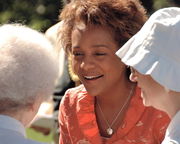
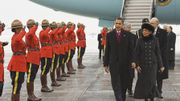
At her investiture ceremony in the Senate chamber on September 27, 2005, Jean declared in a speech described as "moving" that "the time of the Two Solitudes that for too long described the character of this country is past," and called for the protection of the environment, the shielding of culture against globalization, and an end to the marginalisation of young people. According to one media account, "the pomp and circumstance of Canada's most significant state function were blended with humour, passion and even tears."[21] while The Globe and Mail columnist John Ibbitson reflected the general captivation with the new governor general in the following way:
| “ | [H]ere is this beautiful young Canadian of Haitian birth, with a smile that makes you catch your breath, with a bemused older husband by her side, and a daughter who literally personifies our future, and you look at them and you think: Yes, this is our great achievement, this is the Canada that Canada wants to be, this is the Canada that will ultimately make way for different cultural identities.[22] | ” |
Jean focused strongly on the plight of female victims of violence, meeting with representatives of women's organisations during foreign visits, as well as during her visits to Canada's provinces.[23] Also, echoing her inaugural speech, Jean made it her focus during her time as the Queen's representative to break the Two Solitudes, as reflected in the motto on her personal coat of arms: BRISER LES SOLITUDES, which translates into "breaking down solitudes"; this mandate extended beyond simply the relationship between the traditional Two Solitudes of Francophones and Anglophones in Canada to include relations between peoples of all racial, linguistic, cultural, and gender groups. In that vein, the Governor General made an effort to foster national dialogue by launching an online chat with Canadians, as part of the larger project of creating within the Governor General's domain name a website dubbed "Citizen Voices: Breaking Down Solitudes", where users could engage each other in discussion forums and prominent individuals could post blog entries. Jean also commented in an interview on September 18, 2006, regarding a proposed subsidy for Canadians to travel domestically, that Quebecers "are sometimes very disconnected from the rest of Canada" and that their isolation affected Canada's unity. These words raised the ire of Quebec separatist politicians, after which Jean clarified her opinion by adding that Canadians from all provinces were disconnected from other parts of the country.[24][25] A September 26, editorial in the Montreal Gazette, however, supported Jean's statements on the divisions between Canada's peoples, and said that supporting national unity was a part of a governor general's mandate.[26]
Reception
In contrast to her low approval ratings prior to her appointment, crowds were large and welcoming where Jean went as vicereine;[27] only as her convoy arrived at the National War Memorial for her first Remembrance Day ceremony, on November 11, 2005, were Jean and Lafond greeted with disapproval from an audience, when veterans turned their backs on the Governor General and her consort to show contempt for two people the veterans felt had worked to break up the country they had fought to defend.[28] This incident occurred just after Jean made satirical remarks at the roast-like annual National Press Gallery dinner about Parti Québécois leadership candidate André Boisclair's admitted cocaine use.[29]
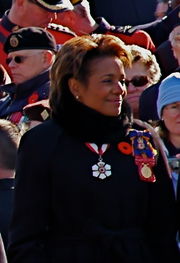
There was some perception that Jean was overstepping the boundaries of an office that was expected to remain non-partisan; journalist Chantal Hébert opined that the Governor General had "been wading uncommonly deep in political territory over the past few months," citing the Jean's criticism of Quebec sovereigntists and her expressed support for the mission of Canadian troops in Afghanistan,[30] and Michael Valpy penned a piece in The Globe and Mail critiquing Jean for inviting who Valpy described as "potentially politically charged individuals" to post on her Citizen Voices website.[31] Further, the content of a speech by Jean to mark the 25th anniversary of the Charter of Rights and Freedoms was regarded as thinly veiled criticism of her Cabinet's decision to end the Court Challenges Program,[32] and, into 2007, it was reported that Jean's staff at Rideau Hall had been systematically removing royal portraits from the walls of the palace. All of this prompted Valpy to reveal that, early in his time as prime minister, Stephen Harper was told by Alex Himelfarb, then the Clerk of the Privy Council: "Prime Minister, your biggest problem is in Rideau Hall," meaning Jean and her potential to be a "loose cannon".[31]
Domestic duties
Observations were made in 2007 that Jean's schedule was seemingly thinner than that of her predecessors; an initial explanation of fatigue was further detailed by the Secretary to the Governor General as thyroid problems, and that the vicereine's doctor had advised rest.[33] Jean had previously been engaged in a hectic schedule, attending to various ceremonial duties, such as presenting the Grey Cup at the 93rd Canadian Football League championship game on November 27, 2005, and opening the Toonik Tyme Festival in Iqaluit, Nunavut, where she donated eighty books in Inuktitut, French, and English to the Centennial Library in commemoration of Queen Elizabeth II's 80th birthday.[34] The next month, on May 4, during her first official visit to the province, Jean became the first governor general to address the Alberta legislature, which preceded her trip to Saskatchewan, where she participated in a historic private discussion with aboriginal women chiefs and elders at Saskatchewan's Government House. She also travelled to France for the 90th anniversary of the Battle of Vimy Ridge, and then back to Trenton, Ontario, for the arrival of the bodies of six Canadian soldiers killed in Afghanistan.
Her first function once recovered was to welcome László Sólyom, President of Hungary, on his state visit to Canada.[33] Then, following in the footsteps of her predecessor, Prince Arthur, Duke of Connaught and Strathearn — the then governor general who opened the first expansion of the museum in 1914 — Jean dedicated the new Michael Lee-Chin Crystal at the Royal Ontario Museum on June 1, 2007.[35] By late 2008, however, the Governor General had to return to Canada in the midst of a state visit in Europe to contend with a parliamentary dispute that endangered the stability of government, as a coalition of three opposition parties in parliament threatened to rescind their confidence in the Cabinet under the chairmanship of Stephen Harper. Choosing to follow constitutional precedent, Jean accepted, after two hours of deliberation, her prime minister's advice to prorogue parliament until late January 2009,[36] thus preventing the possibility of an official vote of non-confidence and a resulting situation wherein Jean would be required to choose between asking the coalition to form a government or dissolving parliament dropping the writs after having allowed an election only four months earlier.[37] Along with the subsequent prorogation of parliament in December 2009 and the earlier calling of an election in October 2008, Jean was for almost two years part of a controversy in the Canadian media that focused on the constitutional relationship between the governor general and the prime minister or the leaders of the parties in opposition.[38]
Jean then travelled to Nunavut in early 2009, and there participated in a traditional Inuit seal feast at a community festival, gutting a seal that had been recently killed by hunters and consuming a piece of the raw heart. While both her immediate predecessor and Prince Charles, Prince of Wales, had previously partaken in raw seal meat in the Canadian Arctic,[39] Jean's simple act drew attention, both positive and negative, because of its coincidence with the European Parliament's recent ban on the import of Canadian seal products.[40][41] When asked by reporters what her motivations were, Jean replied: "Take from that what you will."[42] She also continued, per tradition, to attend Remembrance Day ceremonies, as representative of the Commander-in-Chief; at that event in 2009, Jean, along with Prince Charles, wore army dress uniform.[43] This followed her wearing a naval uniform at the navy's consecration and presentation of the Queen's Colour ceremony in Halifax on June 27, of the same year,[44] marking the revival of a practice that had ceased following the tenure of Ray Hnatyshyn.
At ceremonies held in Vancouver on February 12, 2010, Jean officially opened that year's Winter Olympics and one month later opened the Winter Paralympics in the same city.[45][46] Then, in June, Jean conducted a fleet review in Esquimalt Harbour, to mark the 100th anniversary of the founding of the Royal Canadian Navy.[47] Polls conducted around that time showed that Jean had earned an approval rating of 60%, and a constitutional expert at the University of Toronto called her performance as governor general "superb," though some of her missteps were noted.[48]
International duties
The viceregal family undertook their first international trip in February 2006, journeying to Italy to attend the closing ceremonies of the 2006 Winter Olympics, meet Italian President Carlo Azeglio Ciampi in Torino, and Pope Benedict XVI at the Vatican. Three months later, Jean attended the investiture of René Préval as President of Haiti, Jean's first visit to her homeland in her capacity as the Queen's representative, and where she was greeted with enthusiasm in Jacmel.[49]
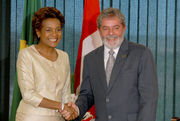
At the end of the year, between November 18 and December 11, 2006, Jean embarked on a trip consisting of state visits to five African countries — Algeria, Mali, Ghana, South Africa, and Morocco — wherein the Governor General encouraged women's rights.[50] She also, in a precedent-breaking move, personally explained on her Citizen Voices website the role of the governor general in undertaking such trips and the reason behind these particular tours throughout Africa,[51] then continuing to post her observations and feelings on her experiences on the continent. In Mali, where she arrived on November 23, 2006, Jean was greeted by tens of thousands of people lining the highway as her motorcade passed, and in the town of Benieli, was presented with a goat, replete with a Canadian flag on its collar.[52] Male vendors also gave Canadian journalists gifts to be passed on to Jean, provided that she also be given their telephone numbers.[53] Further, during the South African leg of the tour, then President Thabo Mbeki praised the Queen-in-Council's decision to appoint Jean as governor general, citing it as an example to European countries of how African immigrants could be treated.[54]
In her capacity as acting commander-in-chief, Jean made on March 8, 2007 her first visit to Canadian troops taking part in the offensive in Afghanistan; she had earlier expressed her desire to go, but Harper advised against such a trip on the grounds of security concerns. Jean landed in Kabul on the same day two attacks were made against Canadian soldiers.[55] The Governor General had the arrival timed specifically for International Women's Day, stating: "the women of Afghanistan may face the most unbearable conditions, but they never stop fighting for survival. Of course, we, the rest of the women around the world, took too long to hear the cries of our Afghan sisters, but I am here to tell them that they are no longer alone. And neither are the people of Afghanistan." Part of the Governor General's itinery included meeting with Afghan women, Canadian soldiers, Royal Canadian Mounted Police teams, humanitarian workers, and diplomats.[56] Other state visits included ones to Norway,[57] Brazil,[58] Croatia,[59] Greece,[59] and Mexico.[60]
The vicereine again won plaudits, though not universal,[61] from the media and public for her actions following the earthquake that devastated her native Haiti on January 12, 2010, in which she lost her friend Magalie Marcelin, godmother to Jean's daughter.[3] The Governor General, with her prime minister, Stephen Harper, attended an emergency meeting at the Department of Foreign Affairs and then made a tearful speech, with parts in Haitian Creole, thanking the Cabinet for its swift action and the Canadian media for its coverage, as well as urging strength and courage to Haitians.[62] She later attended a vigil in Montreal and on January 25, 2010 met at Rideau Hall with Haitian prime minister Jean-Max Bellerive.[63][64] Between March 8 and 10, 2010 the Governor General made a visit to Haiti to observe the devastation and Canadian assistance being meted out there and meet with President Préval.[65][66]
On May 10, 2010, Princess Margriet of the Netherlands presented Jean with a new tulip cultivar named the Michaëlle Jean tulip; with deep maroon petals, it was designed to reflect the Governor General's personal tastes.[67][68][69] This carried on the tradition of Dutch royals gifting tulips to Canada.
End of tenure
Jean announced to the press in early 2010 that she would step out of the viceregal role near the end of the traditional,[70][71] but not official, five year period, and it was in July confirmed that the Queen would be appointing David Lloyd Johnston as Jean's successor on October 1, 2010.[72] At the time, it was also reported that the Secretary-General of the United Nations would be appointing Jean to act as special envoy to Haiti for the United Nations Educational, Scientific and Cultural Organization, with an aim to fight poverty and illiteracy and raise international funds.[73] An eponymous foundation is also planned, as was done for several previous governors general; the Michaëlle Jean Foundation will focus on promoting education, culture, and creativity among youth from rural, northern, and/or poor communities in Canada.[74]
Summaries of Jean's time as the Queen's representative emerged by mid 2010; Jean was regarded as having fulfilled the role in an admirable, though not perfect, fashion. She was commended for her dedication to the arts, Aboriginal Canadians, the Armed Forces, and her outreach to Haiti following the earthquake there, but critiqued for specific incidents, such as referring to herself as Canada's head of state and making public comments that skirted the political.[75][76][77]
Titles, styles, honours, and arms
Titles
| Viceregal styles of Michaëlle Jean (2005-present) |
|
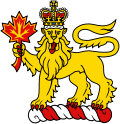 |
|
| Reference style | Her Excellency The Right Honourable Son Excellence la très honorable |
|---|---|
| Spoken style | Your Excellency Votre Excellence |
| Alternative style | Ma'am Madame |
- September 6, 1957 – September 27, 2005: Miss/Madam Michaëlle Jean
- September 27, 2005 – : Her Excellency The Right Honourable Michaëlle Jean, Governor General and Commander-in-Chief in and over Canada
The Governor General's style and title in full is, in English: Her Excellency The Right Honourable Michaëlle Jean, Chancellor and Principal Companion of the Order of Canada, Chancellor and Commander of the Order of Military Merit, Chancellor and Commander of the Order of Merit of the Police Forces, Governor General and Commander-in-Chief in and over Canada, and in French: Son Excellence la très honorable Michaëlle Jean, chancelière et compagnon principale de l'ordre du Canada, chancelière et commandante de l'ordre du mérite militaire, chancelière et commandante de l'ordre du mérite des forces de police, gouverneure générale et commandante en chef du Canada.
Jean's post-nominal letters are, in order according to the Oxford University Calendar Notes on Style:[78] CC, CMM, COM, CD, BA MA PhD(hc) Mont, LLD(hc) Alb, LLD(hc) Man, LLD(hc) Osg, DLitt(hc) McGill, DLitt(hc) Monc, DA(hc) Ott, DIR(hc) Perugia, DUniv(hc) Lav, DMSc(hc) RMC, FRCPSC(hon)
Honours
| Ribbon bars of Michaëlle Jean | |||
|---|---|---|---|
- Appointments
 September 27, 2005 – : Chancellor and Principal Companion of the Order of Canada (CC)[79]
September 27, 2005 – : Chancellor and Principal Companion of the Order of Canada (CC)[79] September 27, 2005 – : Chancellor and Commander of the Order of Military Merit (CMM)[80]
September 27, 2005 – : Chancellor and Commander of the Order of Military Merit (CMM)[80] September 27, 2005 – : Chancellor and Commander of the Order of Merit of the Police Forces (COM)[81]
September 27, 2005 – : Chancellor and Commander of the Order of Merit of the Police Forces (COM)[81] September 27, 2005 – : Dame of Justice, Prior, and Chief Officer in Canada of the Most Venerable Order of the Hospital of Saint John of Jerusalem (DStJ)[82]
September 27, 2005 – : Dame of Justice, Prior, and Chief Officer in Canada of the Most Venerable Order of the Hospital of Saint John of Jerusalem (DStJ)[82] September 27, 2005 – : Chief Scout of Canada
September 27, 2005 – : Chief Scout of Canada 2005 – : Honorary Member of the Royal Military College of Canada Club
2005 – : Honorary Member of the Royal Military College of Canada Club 2007 – : Honorary Fellow of the Royal College of Physicians and Surgeons of Canada (FRCPSC(hon))[83]
2007 – : Honorary Fellow of the Royal College of Physicians and Surgeons of Canada (FRCPSC(hon))[83]
- Medals
 September 27, 2005: Canadian Forces Decoration (CD)
September 27, 2005: Canadian Forces Decoration (CD) 2005: Saskatchewan Centennial Medal
2005: Saskatchewan Centennial Medal
- Awards
 1989: the Human Rights League of Canada Media Award[84]
1989: the Human Rights League of Canada Media Award[84] 1989: Fondation Mireille Lanctôt Prix Mireille-Lanctôt[84]
1989: Fondation Mireille Lanctôt Prix Mireille-Lanctôt[84] 1994: Canadian Broadcasting Corporation Prix Anik[84]
1994: Canadian Broadcasting Corporation Prix Anik[84] 1995: Amnesty International Canada Journalism Award[84]
1995: Amnesty International Canada Journalism Award[84] 1997: City of Montreal Citizen of Honour[84]
1997: City of Montreal Citizen of Honour[84] 2000: Conseil de la Langue Française du Québec Prix Raymond-Charette[84]
2000: Conseil de la Langue Française du Québec Prix Raymond-Charette[84] 2000: Canadian Association of Cable Television Providers Galaxie Award[84]
2000: Canadian Association of Cable Television Providers Galaxie Award[84] 2001: Academy of Canadian Cinema and Television Gemini Award[84]
2001: Academy of Canadian Cinema and Television Gemini Award[84] 2004: Canadian Broadcasting Corporation French Television Prize[84]
2004: Canadian Broadcasting Corporation French Television Prize[84] November 16, 2009: National Quality Institute Recognition of Achievement Award[85]
November 16, 2009: National Quality Institute Recognition of Achievement Award[85]
- Foreign honours
 1985: Swiss Ambassador to Canada's Prize of Excellence in French and Italian studies
1985: Swiss Ambassador to Canada's Prize of Excellence in French and Italian studies 2003: Chevalier du l'Ordre de la Pléiade de l'Association des parlementaires de langue française[84]
2003: Chevalier du l'Ordre de la Pléiade de l'Association des parlementaires de langue française[84]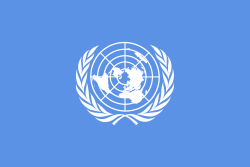 May 28, 2010: United Nations Development Fund for Women Canada Award[86]
May 28, 2010: United Nations Development Fund for Women Canada Award[86]
Honorary military appointments
 September 27, 2005 – : Colonel of the Regiment of the Governor General's Horse Guards
September 27, 2005 – : Colonel of the Regiment of the Governor General's Horse Guards September 27, 2005 – : Colonel of the Regiment of the Governor General's Foot Guards
September 27, 2005 – : Colonel of the Regiment of the Governor General's Foot Guards September 27, 2005 – : Colonel of the Regiment of the Canadian Grenadier Guards
September 27, 2005 – : Colonel of the Regiment of the Canadian Grenadier Guards
Honorary degrees
 June 5, 2006: University of Ottawa, Doctor of Arts (DA)
June 5, 2006: University of Ottawa, Doctor of Arts (DA)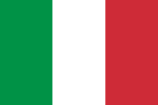 July 21, 2006: Università per Stranieri, Doctor of International Relations (DIR)
July 21, 2006: Università per Stranieri, Doctor of International Relations (DIR) November 10, 2006: McGill University, Doctor of Letters (DLitt)
November 10, 2006: McGill University, Doctor of Letters (DLitt) March 25, 2007: Osgoode Hall Law School at York University, Doctor of Laws (LLD)[87]
March 25, 2007: Osgoode Hall Law School at York University, Doctor of Laws (LLD)[87] June 5, 2007: University of Manitoba, Doctor of Laws (LLD)[88]
June 5, 2007: University of Manitoba, Doctor of Laws (LLD)[88]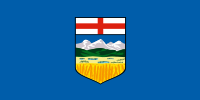 June 10, 2008: University of Alberta, Doctor of Laws (LLD)[89]
June 10, 2008: University of Alberta, Doctor of Laws (LLD)[89] May 23, 2009: Université de Moncton, Doctorate of Letters (DLitt)[90]
May 23, 2009: Université de Moncton, Doctorate of Letters (DLitt)[90] June 14, 2009: Université Laval, Doctor of the University (DUniv)[91][92]
June 14, 2009: Université Laval, Doctor of the University (DUniv)[91][92] May 20, 2010: Royal Military College of Canada, Doctor of Military Science (DMSc)[93]
May 20, 2010: Royal Military College of Canada, Doctor of Military Science (DMSc)[93] May 26, 2010: Université de Montréal, Doctor of Philosophy (PhD)[94][95]
May 26, 2010: Université de Montréal, Doctor of Philosophy (PhD)[94][95]
Honorific eponyms
- Awards
- Geographic locations
- Schools
- Flora
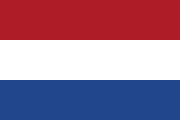 Netherlands: Michaëlle Jean tulip[67][68]
Netherlands: Michaëlle Jean tulip[67][68]
Arms
|
|||||||||||||||||||||||||||||||
See also
- Canadians of Haitian ancestry
- Immigration to Canada
Notes
- ↑ Stephen Harper, then the leader of Her Majesty's Loyal Opposition as head of the Conservative Party, offered his congratulations and said that Jean's life story "serves as a great example to many Canadians. I know Mme Jean will serve Canada in a dignified, viceregal fashion."[8] Jack Layton, leader of the New Democratic Party, said that he wished Jean and her family well, and that he looked "forward to seeing a family again in Rideau Hall, which is fitting for the first Governor-General [sic] of a new century," and went on to say that Jean "knows well the value of the peacekeeping operations that give Canadians so much pride.[9] Bloc Québécois leader Gilles Duceppe expressed disappointment at Jean for deciding to "accept a position... within an institution that is not democratic."
References
- ↑ "Jean, Michaëlle". The UN Refugee Agency. http://www.unhcr.org/3e1eaa6d4.html. Retrieved 2010-06-11.
- ↑ 2.0 2.1 2.2 Office of the Governor General of Canada. "Role and Responsibilities > The Governor General and Her Spouse > Governor General Michaëlle Jean". Queen's Printer for Canada. http://www.gg.ca/document.aspx?id=41. Retrieved January 20, 2010.
- ↑ 3.0 3.1 3.2 Panetta, Alexander (March 8, 2010). "Governor General Michaëlle Jean in quake-ravaged Haiti: 'You are not alone'". Yahoo News. http://ca.news.yahoo.com/s/capress/100308/national/gg_haiti. Retrieved March 11, 2010.
- ↑ Wyatt, Nelson (January 18, 2010). "Canadian troops will focus aid on town with deep ties to GG Michaëlle Jean". Canada East. http://www.canadaeast.com/front/article/924618. Retrieved January 20, 2010.
- ↑ 5.0 5.1 5.2 5.3 5.4 5.5 "Indepth > Governor General Michaëlle Jean". CBC. October 11, 2005. http://www.cbc.ca/news/background/governorgeneral/michaelle_jean.html. Retrieved February 22, 2009.
- ↑ Taber, Jane (February 10, 2010). "Governor-General shares grief with B.C. Haitians". The Globe and Mail. http://www.theglobeandmail.com/news/world/haiti/governor-general-shares-grief-with-bc-haitians/article1463457/. Retrieved February 10, 2010.
- ↑ Office of the Prime Minister (August 4, 2005). "Announcement by Paul Martin of Michaëlle Jean's appointment". Queen's Printer for Canada. http://pm.gc.ca/eng/news.asp?id=556. Retrieved August 8, 2005.
- ↑ Statement from Stephen Harper on the Appointment of New Governor General (August 4, 2005). "Stephen Harper's remarks". Press release. http://www.conservative.ca/EN/news_releases/statement_from_stephen_harper_on_the_appointment_of_new_governor_general/. Retrieved August 4, 2005.
- ↑ New Democratic Party (August 5, 2005). "Layton, NDP welcome Michaëlle Jean as new Governor-General". Press release. http://www.ndp.ca/page/1540. Retrieved August 5, 2005.
- ↑ Government House (August 4, 2005). "Message from Her Excellency the Right Honourable Adrienne Clarkson Governor General of Canada on the announcement of Michaëlle Jean as new Governor General Designate". Press release. http://archive.gg.ca/media/doc.asp?lang=e&DocID=4516. Retrieved August 4, 2005.
- ↑ Peritz, Ingrid (August 11, 2005). "Rideau Hall pick disappoints separatist hard-liners". The Globe and Mail. http://www.theglobeandmail.com/servlet/ArticleNews/TPStory/LAC/20050811/LAFOND11/National/Idx. Retrieved August 11, 2005.
- ↑ Wyatt, Nelson (August 11, 2005). "Separatist says 'Come clean, Jean'". The Globe and Mail. http://www.theglobeandmail.com/servlet/story/RTGAM.20050811.wjean0811. Retrieved August 11, 2005.
- ↑ Canadian Press (August 11, 2005). "GG-designate challenged on 1995 referendum vote". CTV. http://www.ctv.ca/servlet/ArticleNews/story/CTVNews/1123796154319_119205354/?hub=Canada. Retrieved August 11, 2005.
- ↑ 14.0 14.1 "New governor general must clarify sovereignty position, premiers say". CBC. August 12, 2005. http://www.cbc.ca/canada/story/2005/08/12/jean-sovereignty050812.html. Retrieved August 12, 2005.
- ↑ LeBlanc, Daniel (August 13, 2005). "Martin defends viceregal couple's loyalty". The Globe and Mail. http://www.theglobeandmail.com/servlet/story/RTGAM.20050812.wxlafond13/BNStory/National/. Retrieved February 22, 2009.
- ↑ Office of the Prime Minister (August 17, 2005). "Statement by Paul Martin on the Governor General-Designate". Press release. http://pm.gc.ca/eng/news.asp?id=564. Retrieved August 17, 2005.
- ↑ "Haitian community holds special church service for the governor general-designate". CBC. August 27, 2005. http://www.cbc.ca/canada/story/2005/08/27/haitian-church-service-michaelle-jean-080527.html. Retrieved August 27, 2005.
- ↑ Victoria (March 29, 1867). Constitution Act, 1867. III.15. Westminster: Queen's Printer. http://www.solon.org/Constitutions/Canada/English/ca_1867.html. Retrieved February 22, 2009.
- ↑ "New governor general to give up French citizenship". CBC. September 25, 2005. http://www.cbc.ca/canada/story/2005/09/25/jean_citizenship_20050925.html. Retrieved September 25, 2005.
- ↑ Journal Officiel de la République Française, Décret du 23 septembre 2005 portant libération des liens d'allégeance à l'égard de la France
- ↑ Thompson, Elizabeth (September 28, 2005). "Passion and Tears: Jean Sworn In". The Gazette. http://www.canada.com/national/features/governor_general/story.html?id=78549c49-781f-43c0-908d-20f24db2ca5a. Retrieved September 28, 2005.
- ↑ Ibbitson, John (September 28, 2005). "The remarkable new Governor-General". The Globe and Mail. http://www.theglobeandmail.com/servlet/story/RTGAM.20050928.wxibbitson28/BNStory/International/.
- ↑ Canadian Press (May 16, 2007). "GG encourages dialogue to end domestic violence". CTV. http://www.ctv.ca/servlet/ArticleNews/story/CTVNews/20070516/jean_violence_070516/20070516?hub=Canada. Retrieved May 16, 2007.
- ↑ "Le Québec boude le Canada, déplore Michaëlle Jean" (in French). LCN. September 2006. http://lcn.canoe.com/lcn/infos/national/archives/2006/09/20060923-170419.html. Retrieved September 27, 2006.
- ↑ Canadian Press (September 25, 2006). "Governor-General defends remarks on Quebec". Globe and Mail. http://www.theglobeandmail.com/servlet/story/LAC.20060925.NATSTOR25/TPStory/National. Retrieved September 27, 2006.
- ↑ Editorial (September 27, 2006). "Exchanges bring two solitudes closer". Toronto Star. http://www.thestar.com/NASApp/cs/ContentServer?pagename=thestar/Layout/Article_Type1&c=Article&cid=1159307412210&call_pageid=968256290204&col=968350116795. Retrieved September 27, 2006.
- ↑ "Hundreds greet new Governor General". CBC. October 18, 2005. http://www.cbc.ca/manitoba/story/mb_gg20051018.html. Retrieved October 18, 2005.
- ↑ "Canadians honour war dead in solemn ceremony". CTV. November 11, 2005. http://sympaticomsn.ctv.ca/servlet/ArticleNews/story/CTVNews/20051111/Remembrance_Day_051111. Retrieved November 11, 2005.
- ↑ "Governor General criticized by sister over Boisclair jokes". CBC. November 6, 2005. http://www.cbc.ca/canada/story/2005/11/05/jean-051105.html. Retrieved November 6, 2005.
- ↑ Hébert, Chantal (September 27, 2006). "Will Jean thwart election call?;". Toronto Star. http://www.thestar.com/NASApp/cs/ContentServer?pagename=thestar/Layout/Article_Type1&c=Article&cid=1159307412136&call_pageid=968256290204&col=968350116795. Retrieved September 28, 2006.
- ↑ 31.0 31.1 Valpy, Michael (April 24, 2007). "'Your biggest problem is Rideau Hall,' top bureaucrat warned Harper". Globe and Mail. http://www.theglobeandmail.com/servlet/story/LAC.20070424.JEAN24/TPStory/National.
- ↑ Editorial (April 19, 2007). "Her Charter gaffe". Globe and Mail.
- ↑ 33.0 33.1 "Thyroid problem forced Governor General to miss work: office". CBC. April 26, 2007. http://www.cbc.ca/canada/story/2007/04/26/jean-govgeneral.html?ref=rss. Retrieved April 26, 2007.
- ↑ Jean, Michaëlle (April 17, 2006). Her Excellency the Right Honourable Michaëlle Jean Speech on the Occasion of the Opening Ceremony of the Toonik Tyme Festival. Government House. http://archive.gg.ca/media/doc.asp?lang=e&DocID=4728. Retrieved April 17, 2006.
- ↑ Canadian Press (June 1, 2007). "Inside the ROM crystal". Toronto Star. http://www.thestar.com/article/220522. Retrieved February 26, 2009.
- ↑ "GG agrees to suspend Parliament: Harper". CBC. December 4, 2008. http://www.cbc.ca/canada/story/2008/12/04/harper-jean.html. Retrieved December 4, 2008.
- ↑ "The race is on: Harper calls election for Oct. 14". CTV. September 7, 2008. http://www.ctv.ca/servlet/ArticleNews/story/CTVNews/20080907/election_call_080907?s_name=&no_ads=. Retrieved February 26, 2009.
- ↑ Smith, David E. (June 10, 2010). "The Crown and the Constitution: Sustaining Democracy?". The Crown in Canada: Present Realities and Future Options (Kingston: Queen's University): p. 5. http://www.queensu.ca/iigr/conf/ConferenceOnTheCrown/CrownConferencePapers/The_Crown_and_the_Constitutio1.pdf. Retrieved May 18, 2010.
- ↑ Panetta, Alexander (May 31, 2009). "Former GG unimpressed with Jean's seal snack". Toronto Star. http://www.thestar.com/news/canada/article/643294. Retrieved May 31, 2009.
- ↑ "Governor General's seal snack sparks controversy". CBC. May 26, 2009. http://www.cbc.ca/canada/story/2009/05/26/jean-seal.html. Retrieved May 27, 2009.
- ↑ Gormley, John (May 29, 2009). "My apologies to Michaëlle Jean". The StarPhoenix. http://www2.canada.com/saskatoonstarphoenix/columnists/story.html?id=45dfd68e-6b00-478f-b833-04c79dbf8547. Retrieved May 29, 2009.
- ↑ Associated Press (May 26, 2009). "Canada's governor general eats seal heart". San Francisco Chronicle. http://www.sfgate.com/cgi-bin/article.cgi?f=/n/a/2009/05/26/national/a102735D50.DTL. Retrieved May 27, 2009.
- ↑ Benzie, Robert (November 11, 2009). "Royals join Canadians for Remembrance Day". Toronto Star. http://www.thestar.com/news/canada/remembranceday/article/724247. Retrieved January 20, 2010.
- ↑ "Jean presents new flag to the Canadian navy". CBC. June 27, 2009. http://www.cbc.ca/canada/story/2009/06/27/queen-colour.html. Retrieved January 20, 2010.
- ↑ Canadian Press (June 27, 2009). "Gov. Gen. Jean to open 2010 Games: PM". Edmonton Sun. http://www.edmontonsun.com/sports/2009/06/27/9958406-cp.html. Retrieved August 14, 2009.
- ↑ Queen's Printer for Canada (March 12, 2010). "Governor General to open the Vancouver 2010 Paralympic Winter Games". Press release. http://www.gg.ca/document.aspx?id=13554. Retrieved March 12, 2010.
- ↑ DeRosa, Katie (June 12, 2010). "Governor General conducts fleet review to mark navy centennial". National Post. http://www.nationalpost.com/news/Governor+General+conducts+fleet+review+mark+navy+centennial/3147422/story.html. Retrieved June 13, 2010.
- ↑ Weese, Brian (April 10, 2010). "Michaëlle Jean will leave big shoes to fill". Toronto Sun. http://www.torontosun.com/news/canada/2010/04/10/13539211-qmi.html. Retrieved April 11, 2010.
- ↑ "Governor General visits her family's hometown in Haiti". CBC. May 16, 2006. http://www.cbc.ca/world/story/2006/05/16/jean05162006.html. Retrieved May 18, 2006.
- ↑ Panetta, Alexander (November 22, 2006). "Jean welcomed by 'brothers and sisters'". Toronto Star. http://www.thestar.com/NASApp/cs/ContentServer?pagename=thestar/Layout/Article_Type1&call_pageid=971358637177&c=Article&cid=1164235812148. Retrieved November 30, 2006.
- ↑ Jean, Michaëlle (November 19, 2006). "BLOGG > Canada and Africa". http://www.citizenvoices.gg.ca/en/blogs/michaelle_jean/25. Retrieved November 30, 2006.
- ↑ Canadian Press (November 27, 2006). "Malis gives GG thanks, and a goat". Toronto Star. http://www.thestar.com/news/canada/article/123644--malis-gives-gg-thanks-and-a-goat. Retrieved August 21, 2010.
- ↑ Panetta, Alexander (November 25, 2006). "Press in Mali gives GG thanks, and a Goat". Toronto Star. http://www.thestar.com/NASApp/cs/ContentServer?pagename=thestar/Layout/Article_Type1&call_pageid=971358637177&c=Article&cid=1164409811440. Retrieved November 30, 2007.
- ↑ Associated Press (December 5, 2006). "South Africa's president praises Canada's first black governor general for setting an example for immigrants". Herald Tribune. http://www.iht.com/articles/ap/2006/12/05/africa/AF_GEN_South_Africa_Canada.php. Retrieved March 25, 2009.
- ↑ Canadian Press (March 8, 2007). "GG visits Canadian troops". Toronto Star. http://www.thestar.com/News/article/189686. Retrieved March 15, 2007.
- ↑ Office of the Governor General of Canada (March 8, 2007). "Governor General and Commander-in-Chief of Canada undertakes first visit to Afghanistan". Press release. http://archive.gg.ca/media/doc.asp?lang=e&DocID=4994. Retrieved March 15, 2007.
- ↑ Queen's Printer for Canada (April 15, 2009). "Governor General to Undertake State Visits to Ukraine and Norway". Press release. http://www.gg.ca/document.aspx?id=13070. Retrieved November 2, 2009.
- ↑ Queen's Printer for Canada (June 27, 2007). "Governor General to visit Salvador, Brasilia, Sao Paulo and Rio de Janeiro as part of State Visit to Brazil". Press release. http://www.gg.ca/document.aspx?id=12516. Retrieved November 2, 2009.
- ↑ 59.0 59.1 Queen's Printer for Canada (October 14, 2009). "Governor General to Undertake Visits to Slovenia, Croatia and Greece". Press release. http://www.gg.ca/document.aspx?id=13299. Retrieved November 2, 2009.
- ↑ Office of the Govenror General of Canada. "Active and Engaged > Representing Canada > Abroad > State Visits > State Visit to Mexico". Queen's Printer for Canada. http://www.gg.ca/document.aspx?id=13415&lan=eng. Retrieved December 12, 2009.
- ↑ Siddiqui, Haroon (January 17, 2010). "Michaëlle Jean and Stephen Harper do us proud in Haiti". Toronto Star. http://www.thestar.com/opinion/article/751486#article. Retrieved January 17, 2010.
- ↑ MacCharles, Tonda (January 13, 2010). "Governor General delivers tearful statement on Haiti". Toronto Star. http://www.thestar.com/news/world/haiti/article/750385--governor-general-delivers-tearful-statement-on-haiti. Retrieved January 14, 2010.
- ↑ Queen's Printer for Canada (January 21, 2010). "Governor General Attends a Vigil of Hope at La TOHU". Press release. http://www.gg.ca/document.aspx?id=13492. Retrieved January 25, 2010.
- ↑ Queen's Printer for Canada (January 25, 2010). "Governor General to meet Prime Minister of Haiti". Press release. http://www.gg.ca/document.aspx?id=13498. Retrieved January 25, 2010.
- ↑ Leeder, Jessica (March 7, 2010). "Governor-General to land in Port-au-Prince for two-day tour". The Globe and Mail. http://www.theglobeandmail.com/news/world/haiti/project-jacmel/governor-general-to-land-in-port-au-prince-for-two-day-tour/article1493139/. Retrieved March 8, 2010.
- ↑ Canwest News Service (March 8, 2010). "Michaëlle Jean arrives in Haiti". National Post. http://www.nationalpost.com/news/story.html?id=2654140. Retrieved March 8, 2010.
- ↑ 67.0 67.1 Hempstead, Doug. (May 12, 2010). Michaelle Jean Tulip unveiled. [Adobe Flash]. Ottawa: Canoe.
- ↑ 68.0 68.1 Hempstead, Doug (May 12, 2010). "Dutch princess visits Rideau Hall". Ottawa Sun. http://www.ottawasun.com/news/ottawa/2010/05/12/13923666.html. Retrieved May 26, 2010.
- ↑ Office of the Governor General of Canada. "Her Royal Highness Princess Margriet of the Netherlands at Rideau Hall". Queen's Printer for Canada. http://www.gg.ca/document.aspx?id=13629. Retrieved May 26, 2010.
- ↑ Panetta, Alexander (April 14, 2010). "Michaëlle Jean confirme que son mandat prendra fin en septembre". La Presse. http://www.cyberpresse.ca/actualites/quebec-canada/politique-canadienne/201004/14/01-4270467-michaelle-jean-confirme-que-son-mandat-prendra-fin-en-septembre.php. Retrieved April 14, 2010.
- ↑ Greenway, Norma (April 14, 2010). "Michaëlle Jean's term to end in September". The Gazette. http://www.montrealgazette.com/life/Micha%C3%ABlle+Jean+term+September/2906950/story.html. Retrieved April 14, 2010.
- ↑ Ibbitson, John (July 8, 2010). "Next governor-general unveiled". Globe and Mail. http://www.theglobeandmail.com/news/politics/ottawa-notebook/next-governor-general-unveiled/article1632781/. Retrieved July 8, 2010.
- ↑ Boesveld, Sarah (June 21, 2010). "Governor-General's next role will be special envoy for UN". The Globe and Mail. http://www.theglobeandmail.com/news/politics/governor-generals-next-role-will-be-special-envoy-for-un/article1612618/. Retrieved June 22, 2010.
- ↑ Cohen, Tobi (June 22, 2010). "Michaëlle Jean lands UN post, starts foundation". National Post. http://www.nationalpost.com/Mich%C3%A4elle+Jean+lands+post+starts+foundation/3186156/story.html#ixzz0rbozdbbK. Retrieved June 22, 2010.
- ↑ Editorial Board (June 22, 2010). "Michaëlle Jean grew in the viceregal office". The Globe and Mail. http://www.theglobeandmail.com/news/opinions/editorials/michalle-jean-grew-in-the-viceregal-office/article1613940/. Retrieved June 24, 2010.
- ↑ Posner, Michael (June 22, 2010). "Jean's G-G tenure marked by euphoria and controversy". The Globe and Mail. http://www.theglobeandmail.com/news/politics/jeans-g-g-tenure-marked-by-euphoria-and-controversy/article1614003/. Retrieved June 24, 2010.
- ↑ Editorial Board (2010). "The Conscience of a Nation". Canadian Monarchist News (Toronto: Monarchist League of Canada) Spring-Summer 2010 (31): 15. http://www.monarchist.ca/cmn/2010/Spring_Summer_2010%20CMN_lr.pdf. Retrieved June 24, 2010.
- ↑ Oxford University Gazette > Oxford University Calendar > Notes on Style. University of Oxford. http://www2.ox.ac.uk/gazette/calendar/style.pdf. Retrieved July 27, 2010.
- ↑ Office of the Governor General of Canada. "Honours > Order of Canada". Queen's Printer for Canada. http://archive.gg.ca/honours/nat-ord/oc/index_e.asp. Retrieved February 26, 2009.
- ↑ Office of the Governor General of Canada. "Honours > Order of Military Merit". Queen's Printer for Canada. http://archive.gg.ca/honours/nat-ord/omm/index_e.asp. Retrieved February 26, 2009.
- ↑ Office of the Governor General of Canada. "Honours > Order of Merit of the Police Forces". Queen's Printer for Canada. http://archive.gg.ca/honours/nat-ord/ormp/index_e.asp. Retrieved February 26, 2009.
- ↑ Office of the Governor General of Canada. "Honours > Insignia Worn by the Governor General". Queen's Printer for Canada. http://archive.gg.ca/gg/rr/ins/index_e.asp. Retrieved February 26, 2009.
- ↑ Office of the Governor General of Canada (January 25, 2007). "Governor General to be Inducted as Honorary Fellow of The Royal College of Physicians and Surgeons of Canada". Press release. http://archive.gg.ca/media/doc.asp?lang=e&DocID=4953. Retrieved January 28, 2007.
- ↑ 84.0 84.1 84.2 84.3 84.4 84.5 84.6 84.7 84.8 84.9 Office of the Governor General of Canada. "Governor General > Her Excellency the Right Honourable Michaëlle Jean, C.C., C.M.M., C.O.M., C.D., Governor General and Commander-in-Chief of Canada". Queen's Printer for Canada. http://archive.gg.ca/gg/bio/index_e.asp. Retrieved February 26, 2009.
- ↑ Office of the Governor General of Canada. "Media > Photos > Governor General honoured with Recognition of Achievement Award from the National Quality Institute". Queen's Printer for Canada. http://www.gg.ca/gallery.aspx?ID=10093. Retrieved February 4, 2010.
- ↑ Queen's Printer for Canada (May 28, 2010). "Governor General to Receive UNIFEM Canada Award". Press release. http://www.gg.ca/document.aspx?id=13667. Retrieved June 7, 2010.
- ↑ "Osgoode Hall Law School Convocation conferring honorary degree on Her Excellency the Right Honourable Michaëlle Jean". York University. http://www.yorku.ca/mygraduation/Convocation/webcast/March2007/mar2007archive.htm. Retrieved February 26, 2009.
- ↑ Jean, Michaëlle (June 5, 2007). Speech on the Occasion of the Presentation of an Honorary Doctorate from the University of Manitoba. Office of the Governor General of Canada. http://archive.gg.ca/media/doc.asp?lang=e&DocID=5091. Retrieved June 10, 2007.
- ↑ "University of Alberta Senate > Honorary Degrees > Past Honorary Degree Recipients > J". University of Alberta. http://www.uofaweb.ualberta.ca/senate/honorarydegreeslist.cfm#J. Retrieved April 28, 2009.
- ↑ "Honorary Doctorate from the Université de Moncton". Governor General of Canada. http://archive.gg.ca/media/doc.asp?lang=e&DocID=5749. Retrieved May 26, 2009.
- ↑ Office of the Governor General of Canada. "Governor General receives an honorary doctorate from the Université Laval". Queen's Printer for Canada. http://archive.gg.ca/media/doc.asp?lang=e&DocID=5774. Retrieved June 21, 2009.
- ↑ Larose, Yvon (June 18, 2009). "Des moments forts et inoubliables". Au fil des événements (Quebec City: Université Laval) 44 (34). http://www.aufil.ulaval.ca/articles/des-moments-forts-inoubliables-17711.html. Retrieved June 21, 2009.
- ↑ Department of National Defence. "Archives > Photo of the Day > May 20, 2010 - Royal Military College of Canada, Kingston, Ontario". Queen's Printer for Canada. http://www.forces.gc.ca/site/gal/photos-eng.asp?id=238. Retrieved May 21, 2010.
- ↑ Queen's Printer for Canada (May 26, 2010). "Governor General to Receive an Honorary Degree from the Université de Montréal". Press release. http://www.gg.ca/document.aspx?id=13663. Retrieved June 7, 2010.
- ↑ Langlois, Sophie (May 19, 2010). "Honorary degrees awarded to 11 outstanding personalities". Nouvelles (Montreal: Université de Montréal). http://www.nouvelles.umontreal.ca/udem-news/news/20100519-honorary-degrees-awarded-to-11-outstanding-personalities.html. Retrieved June 7, 2010.
- ↑ Jean, Michaëlle (January 27, 2010). "Launch of the Michaëlle Jean and Jean-Daniel Lafond Endowment Fund". In Office of the Governor General of Canada. Media > Documents > News Releases. Ottawa: Queen's Printer for Canada. http://www.gg.ca/document.aspx?id=13499. Retrieved February 1, 2010.
- ↑ Office of the Governor General of Canada (19 August 2010). "Regional Visits to Saskatchewan and Manitoba". Queen's Printer for Canada. http://www.gg.ca/document.aspx?id=13831. Retrieved 26 August 2010.
- ↑ Canadian Heraldic Authority (September 20, 2005). "The Public Register of Arms, Flags, and Badges of Canada > Michaëlle Jean". Queen's Printer for Canada. http://www.gg.ca/heraldry/pub-reg/project-pic.asp?lang=e&ProjectID=929&ProjectElementID=3456. Retrieved September 23, 2008.
External links
- Website of the Governor General of Canada entry for Michaëlle Jean
- Citizen Voices: Breaking Down Solitudes; Governor General's blog and discussion forum site
- Buckingham Palace statement on Queen's approval of appointment
- Slideshow of the installation of Michaëlle Jean as Governor General of Canada
- Video of Michaëlle Jean's installation as Governor General of Canada
- (French) La Quinzaine Éducation-Médias: Biographie de Michaëlle Jean
- The Canadian Encyclopedia entry for Michaëlle Jean
| Order of precedence | ||
|---|---|---|
| Preceded by The sovereign |
Canadian order of precedence | Succeeded by Members of the Royal Family other than the Queen |
|
|||||
|
||||||||
